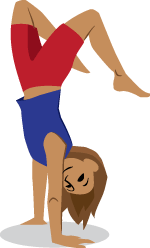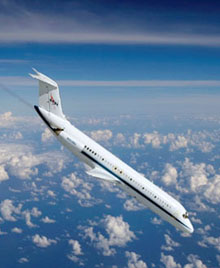show/hide words to know
Bones and Balance

Gravity helps us keep our balance and lets us know which way is up, even when we're upside down!
Astronauts may get to have a lot of fun, but they lose a few things in space, including the strength of their bones and their balance.
As we walk and run on Earth, our muscles pull on our bones, making them stronger. In space, an astronaut’s muscles take a break from tugging on their bones, and with all the floating they do, their bones don’t have to support normal body weight. When bones aren’t used, they get much weaker, so when astronauts return to Earth, they find their bones can’t support their full weight as well as before.
Which Way is Up?
On Earth, gravity is important in helping our bodies figure out which way is up and which way is down. Our sense of balance tells our brain what our arms and legs are doing, whether we are moving or standing still, and whether we’ve somehow ended up upside down, in a hand stand.

Planes such as the Weightless Wonder let astronauts experience weightlessness. If you have been on roller coaster ride, you might have also felt a brief moment of weightlessness.
The weightlessness of space is confusing for our sense of balance. Arms and legs don’t weigh anything without gravity, so the body thinks they have disappeared. There is no sense of up or down, so an astronaut can’t tell if they are standing straight or are hanging upside down.
If you’ve ever experienced a dizzy spell or gotten sick from a roller coaster, you know that feeling off balance can make you queasy. The same way you might get sick in a car or on a boat, a lot of astronauts feel off balance in space and throw up. After a few days, this feeling passes as the astronauts get used to the weightlessness of space.
Astronauts are also able to train for this feeling in planes that are flown high and allowed to fall over safe distances. Over the years, these aircrafts have been known by names such as the Weightless Wonder, and more lovingly, the Vomit Comet. To see the plane in action and learn how low-gravity is simulated on Earth, watch the video from the RIT University News.
View Citation

Underwater facilities on Earth help astronauts train for living and working in space.
Be Part of
Ask A Biologist
By volunteering, or simply sending us feedback on the site. Scientists, teachers, writers, illustrators, and translators are all important to the program. If you are interested in helping with the website we have a Volunteers page to get the process started.








